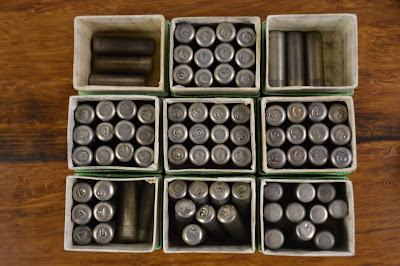This article has been edited and included in The Leadhead's Pencil Blog Volume 4; copies are available print on demand through Amazon here, and I offer an ebook version in pdf format at the Legendary Lead Company here.
If you don't want the book but you enjoy this article, please consider supporting the Blog project here.
“Moses Cohen’s / Everpoint Leads / New York.”
A complete run of boxes from number one through number nine, too! There was a duplicate Number 4 box, so I gave that one to Joe Nemecek. Inside each one of these little boxes were tiny metal tubes:
And each of those metal tubes was marked with a number, generally matching the label on the box lid. The 2, 4, 5 and 6 were full with an even dozen each; the only number not represented was number 3 (that box had three tubes of No. 5s in it):
Note that the number nines are marked “IX,” so you can’t confuse them with a six. Nice touch. Curiosity got the best of me, so I opened up a tube of No. 1 leads and No. 9 leads to see if there were any obvious differences. There were:
The No. 1 leads were significantly fatter. Were there nine different sizes of lead represented here? Were sizes that chaotic in Victorian times? I pulled out a micrometer to see, and yes, there were and yes, they were. Here’s the diameters of the respective sizes:
No. 1: .0535 inches
No. 2: .0500 inches
No. 3: ? [probably .0475 inches]
No. 4: .0450 inches
No. 5: .0420 inches
No. 6: .0410 inches
No. 7: .0385 inches
No. 8: .0340 inches
No. 9: .0335 inches
The use of the term “Everpoint Lead” was an indicator that these were very early production – “Everpoint” was the generic term for a mechanical pencil long before words like “propelling” came into general use. How early this story would take me back, though, surprised me.
The first time a Cohen is found in New York selling Everpoint leads is in 1827, just five years after the first mechanical pencil was patented in England in 1822. The earliest advertisement ran in the New York Evening Post on June 6, 1827, for an “L.I. Cohen” at 30 Pine Street:
On October 16, 1830, Lewis J. Cohen announced that he was heading back to London for a few months, but not to worry: “so as to ensure no disappointment to his customers during his absence,” he left John Pendleton with an adequate supply of goods at his store, now located at 71 Williams.
There’s no record concerning when Cohen got back from England, but he didn’t return to the New York press until 1833, with the publication of an announcement that first ran in the Evening Post on March 29, 1833:
Some charlatan was selling “hawking about the city leads as made by me,” Cohen states, which was made from glue and “common black lead dust.” When exposed to moisture, the fake stuff would swell to twice its normal size and dissolve, essentially gluing the innards of your Everpoint pencils. Lewis Cohen’s leads, on the other hand, were made of “solid Cumberland lead,” his stocks of which were probably replenished during his trip back to England.
Who was this charlatan? The notice says “leads as made by me,” suggesting that they were being sold under the Cohen name. Could my stash of Moses Cohen leads be the fakes Lewis complained of? I don’t think so: my Moses Cohen leads pass the water test with flying colors. Did Lewis Cohen’s trusty assistant John Pendleton run out of Everpoint lead during Cohen’s absence and improvise? Maybe. It’s also possible some other random, spurious huckster saw an opportunity.
By 1836, Lewis Cohen had moved to 122 Williams Street, where his “Stationer’s Warehouse” sold a variety of goods, including (at the very end of the announcement) “Everpoint Leads.”
The earliest New York Directory I could find on line was Longworth’s 1835 directory, which lists Lewis Cohen as a stationer, located at 122 William Street. Moses Cohen is also listed as a “quillmanufacturer” on Second Avenue:
Were the Cohens related? Two guys named “Cohen” in New York City . . . maybe, maybe distantly, maybe so distantly that you’d say no. Did Lewis turn over production of his leads to Moses at some point? Perhaps. Another stationer in New York, William Wise, Jr., began advertising the sale of “Cohen’s fine pencil leads” at 79 Fulton Street in 1843, and he doesn’t say which Cohen:
What’s interesting about this is that even though this announcement ran from time to time for three years without a change of address, I can’t find any corroboration in the city directories that he was there. The 1842-1843 directory doesn’t list him; in fact, in that edition, Moses Cohen isn’t listed, either. The 1845-46 directory lists a William G. Wise, but at 114 Front Street.
I think Wise was selling Moses’ leads. In the 1846-7 directory, Lewis Cohen is still listed as a stationer selling “Everpoint Leads” on Williams Street, and Moses is still in “quills” at 27 First Avenue:
However, the 1847-1848 directory adds another address to Moses Cohen’s quill business: 79 Fulton Street, the same address at which William Wise Jr. was offering “Cohen’s fine pencil leads”:
Was there a relationship between L.I. Cohen, the stationer who manufactured Everpoint leads at 122 William Street, and Moses Cohen, the quillmaker who also marketed Everpoint leads at 79 Fulton Street?
It’s a small world, but not that small. Yes, I think there was a relationship between them.



















No comments:
Post a Comment